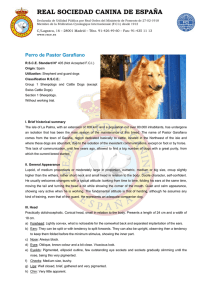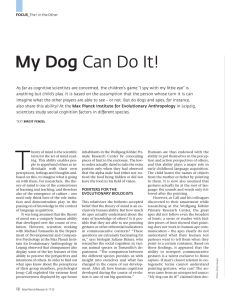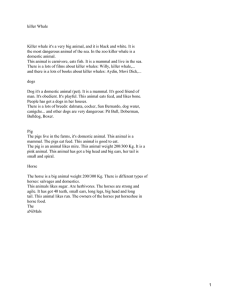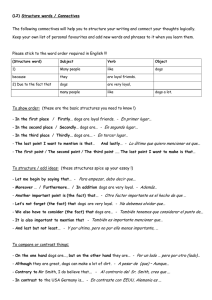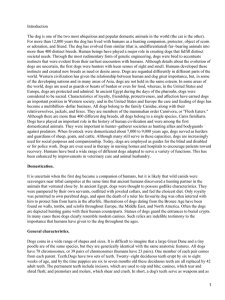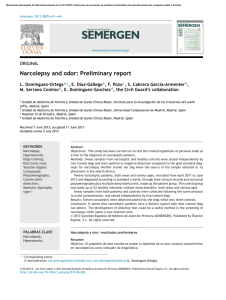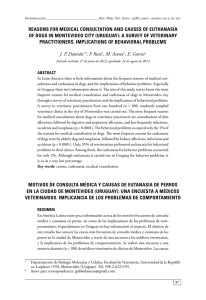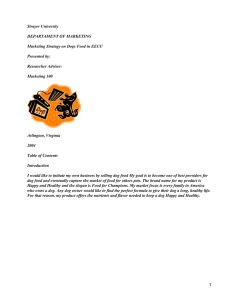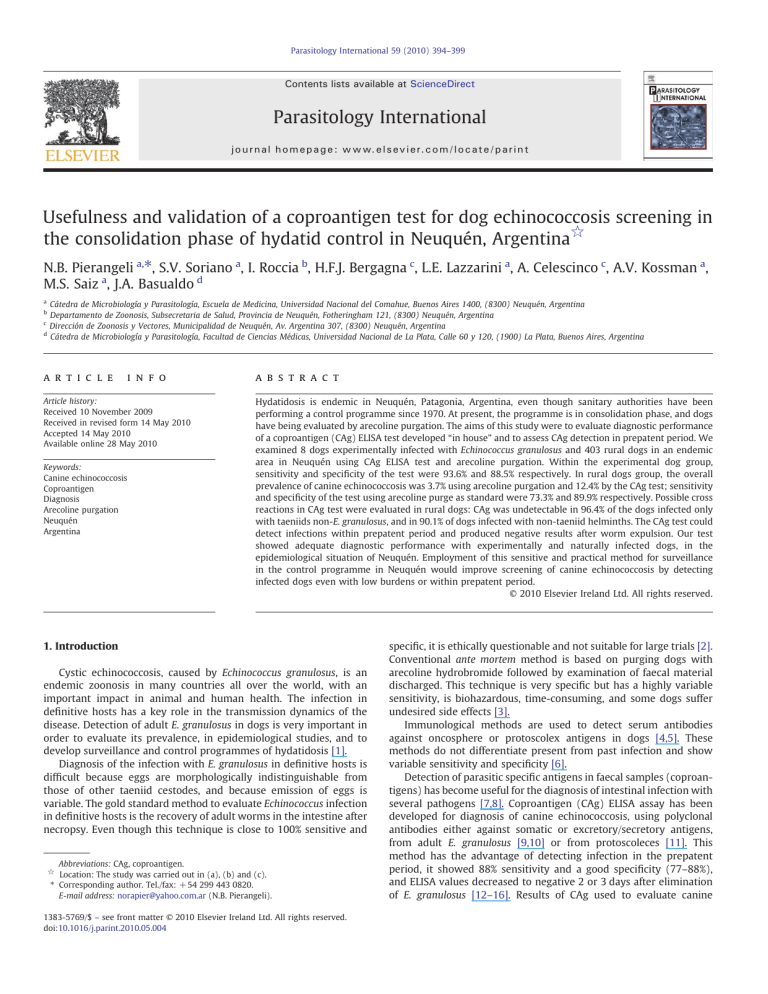
Parasitology International 59 (2010) 394–399 Contents lists available at ScienceDirect Parasitology International j o u r n a l h o m e p a g e : w w w. e l s ev i e r. c o m / l o c a t e / p a r i n t Usefulness and validation of a coproantigen test for dog echinococcosis screening in the consolidation phase of hydatid control in Neuquén, Argentina☆ N.B. Pierangeli a,⁎, S.V. Soriano a, I. Roccia b, H.F.J. Bergagna c, L.E. Lazzarini a, A. Celescinco c, A.V. Kossman a, M.S. Saiz a, J.A. Basualdo d a Cátedra de Microbiología y Parasitología, Escuela de Medicina, Universidad Nacional del Comahue, Buenos Aires 1400, (8300) Neuquén, Argentina Departamento de Zoonosis, Subsecretaria de Salud, Provincia de Neuquén, Fotheringham 121, (8300) Neuquén, Argentina Dirección de Zoonosis y Vectores, Municipalidad de Neuquén, Av. Argentina 307, (8300) Neuquén, Argentina d Cátedra de Microbiología y Parasitología, Facultad de Ciencias Médicas, Universidad Nacional de La Plata, Calle 60 y 120, (1900) La Plata, Buenos Aires, Argentina b c a r t i c l e i n f o Article history: Received 10 November 2009 Received in revised form 14 May 2010 Accepted 14 May 2010 Available online 28 May 2010 Keywords: Canine echinococcosis Coproantigen Diagnosis Arecoline purgation Neuquén Argentina a b s t r a c t Hydatidosis is endemic in Neuquén, Patagonia, Argentina, even though sanitary authorities have been performing a control programme since 1970. At present, the programme is in consolidation phase, and dogs have being evaluated by arecoline purgation. The aims of this study were to evaluate diagnostic performance of a coproantigen (CAg) ELISA test developed “in house” and to assess CAg detection in prepatent period. We examined 8 dogs experimentally infected with Echinococcus granulosus and 403 rural dogs in an endemic area in Neuquén using CAg ELISA test and arecoline purgation. Within the experimental dog group, sensitivity and specificity of the test were 93.6% and 88.5% respectively. In rural dogs group, the overall prevalence of canine echinococcosis was 3.7% using arecoline purgation and 12.4% by the CAg test; sensitivity and specificity of the test using arecoline purge as standard were 73.3% and 89.9% respectively. Possible cross reactions in CAg test were evaluated in rural dogs: CAg was undetectable in 96.4% of the dogs infected only with taeniids non-E. granulosus, and in 90.1% of dogs infected with non-taeniid helminths. The CAg test could detect infections within prepatent period and produced negative results after worm expulsion. Our test showed adequate diagnostic performance with experimentally and naturally infected dogs, in the epidemiological situation of Neuquén. Employment of this sensitive and practical method for surveillance in the control programme in Neuquén would improve screening of canine echinococcosis by detecting infected dogs even with low burdens or within prepatent period. © 2010 Elsevier Ireland Ltd. All rights reserved. 1. Introduction Cystic echinococcosis, caused by Echinococcus granulosus, is an endemic zoonosis in many countries all over the world, with an important impact in animal and human health. The infection in definitive hosts has a key role in the transmission dynamics of the disease. Detection of adult E. granulosus in dogs is very important in order to evaluate its prevalence, in epidemiological studies, and to develop surveillance and control programmes of hydatidosis [1]. Diagnosis of the infection with E. granulosus in definitive hosts is difficult because eggs are morphologically indistinguishable from those of other taeniid cestodes, and because emission of eggs is variable. The gold standard method to evaluate Echinococcus infection in definitive hosts is the recovery of adult worms in the intestine after necropsy. Even though this technique is close to 100% sensitive and Abbreviations: CAg, coproantigen. ☆ Location: The study was carried out in (a), (b) and (c). ⁎ Corresponding author. Tel./fax: + 54 299 443 0820. E-mail address: [email protected] (N.B. Pierangeli). 1383-5769/$ – see front matter © 2010 Elsevier Ireland Ltd. All rights reserved. doi:10.1016/j.parint.2010.05.004 specific, it is ethically questionable and not suitable for large trials [2]. Conventional ante mortem method is based on purging dogs with arecoline hydrobromide followed by examination of faecal material discharged. This technique is very specific but has a highly variable sensitivity, is biohazardous, time-consuming, and some dogs suffer undesired side effects [3]. Immunological methods are used to detect serum antibodies against oncosphere or protoscolex antigens in dogs [4,5]. These methods do not differentiate present from past infection and show variable sensitivity and specificity [6]. Detection of parasitic specific antigens in faecal samples (coproantigens) has become useful for the diagnosis of intestinal infection with several pathogens [7,8]. Coproantigen (CAg) ELISA assay has been developed for diagnosis of canine echinococcosis, using polyclonal antibodies either against somatic or excretory/secretory antigens, from adult E. granulosus [9,10] or from protoscoleces [11]. This method has the advantage of detecting infection in the prepatent period, it showed 88% sensitivity and a good specificity (77–88%), and ELISA values decreased to negative 2 or 3 days after elimination of E. granulosus [12–16]. Results of CAg used to evaluate canine N.B. Pierangeli et al. / Parasitology International 59 (2010) 394–399 echinococcosis in different geographical regions confirm the usefulness of this assay in epidemiological surveys [13,14,17–20]. However, several studies have demonstrated that sensitivity of CAg tests is dependent on the worm burden, and that the diagnostic parameters of sensitivity and specificity vary in different epidemiological situations [12,18]. In Neuquén, where hydatidosis is endemic, provincial sanitary authorities have been carrying out a control programme of cystic echinococcosis since 1970. This programme is based on anthelmintic treatment of dogs, sanitary education, slaughter control and notification of confirmed human cases. At present, the control programme is in consolidation phase, and infection in dogs is still evaluated by purge with arecoline hydrobromide. In 1970, at the beginning of the programme echinococcosis prevalence in dogs was 28.2% and it decreased to 2.9% in 1990. According to official data, prevalence of dog echinococcosis in Neuquén has being remained in a steady state at about 1.0% since 1996 [21]. However, the overall mean annual incidence of human hydatid disease in the province of Neuquén for the period 1995–2004 was 24.4 per 100,000 inhabitants within the total population and 9.7/100,000 in the 0–14 year group [22]. Considering this particular epidemiological situation in Neuquén, the purge with arecoline seems to be inadequate to evaluate canine echinococcosis [12,18]. It would be necessary to change the arecoline purge used for the surveillance of dog echinococcosis for a more sensitive and practical method as the CAg test. Commercial kits for CAg assay are not available in Argentina, so it was necessary to develop a test “in house” and therefore to evaluate its efficacy before using it in the Province Hydatid Control Programme. In order to improve screening of canine echinococcosis in a longterm control area, the aims of this study were to evaluate the diagnostic performance (sensitivity, specificity, predictive value and precision) of the coproantigen ELISA test developed “in house”, with both experimentally and naturally infected dogs, as well as to assess coproantigen detection in the prepatent period. 2. Materials and methods Fig. 1. Geographic location. A: Argentina Argentina. B: Sanitary Area IV in Neuquén. 395 in South America and Neuquén in Group A: 8 dogs were used for validation of the test with experimental infection and in time-course experiments. Dogs from urban areas of Neuquén of mixed breed aged between 6 month and 5 years old were kept in individual kennels and treated orally with praziquantel (5 mg/kg) and albendazole (50 mg/kg) one week before infection. They were maintained on commercial dried food and water ad libitum according to biosafety and ethical regulations. Two dogs from this group (Group A1) were kept as uninfected controls and 6 were infected with E. granulosus (Group A2). Group B: 403 rural dogs under Province Control Programme belonging to Sanitary Zone IV of Neuquén were included in the field trial. To assess possible cross reactions, 367 dogs of Group B that showed infection with other parasites but were negative for E. granulosus, were classified in 3 sub groups, as follows: Group B1: 268 helminths-free dogs; Group B2: 28 dogs with natural infection with taeniid different from E granulosus and Group B3: 71 dogs with natural infection with non-taeniid helminths. Presence or absence of helminths in these dogs was assessed by both arecoline purgation and/or coprological exam. 2.1. Experimental design and study area 2.3. Parasite material and experimental infections This study included two parts. The first part was carried out with experimentally infected dogs and comprises validation of the CAg ELISA test as well as detection of CAg in time-course experiments. For these purposes a prospective experimental design was carried out between March and September 2005. In the second one, we carried out a field trial to validate the CAg test against arecoline purgation with natural infected dogs in a rural area of the province of Neuquén, Patagonia Argentina. We also assessed the influence of the possible low burden of E. granulosus and the presence of other helminths in naturally infected dogs on the sensitivity and on the specificity of coproantigen detection. In this case, we applied a descriptive observational cross sectional design between June 2005 and October 2008. The Province of Neuquén is located in the north of the Argentinean Patagonia and its public health system is organized in 6 Sanitary Zones (Fig. 1). The study area corresponds to small rural communities of the Sanitary Zone IV, where human hydatid disease showed one of highest incidence rates in the province [22]. The main economic activity is raising livestock for subsistence; goats are the most common livestock, but sheep and cattle are also raised. The canine population in the studied area composed by shepherd and guarding dogs is included in the Province Hydatid Control Programme, in which dogs' owners carried out dosing of rural dogs with praziquantel every 6 weeks [21]. 2.2. Animals The dogs evaluated in this study were classified in 2 groups, A and B, as follows. For experimental infections, fertile pulmonary hydatid cysts were obtained from goats slaughtered in abattoirs of Chos Malal, in the north of the Province of Neuquén. Protoscoleces viability was assessed by observation of flame cell activity with 100× with an optic microscope and vital stain with 0.4% Tripan Blue. Dogs from Group A2 were orally infected with a dose of 20.000–50.000 protoscoleces with a viability of 80–95%. 2.4. Collection of samples To validate the CAg test with Group A dogs, we randomly selected 35 fresh faecal samples from uninfected dogs (Group A1) and 47 samples of confirmed infected dogs (Group A2). Infection was confirmed by arecoline purgation at 35 days post infection (dpi). All faecal samples were stored at − 20 °C for further CAg assay. For Group B, trained staff of the Control Programme obtained faecal samples during periodic visit to farms. Dogs were brought voluntarily by their owners to the testing area and were dosed with 4 mg/kg of arecoline hydrobromide according to standard procedures [23]. After purge, the first portion of faeces was collected separately in a plastic container and the rest of the purge was examined in a black tray. Helminths found in purge were identified as previously described [24]. Only dogs from which both samples could be obtained were included in this study. Once in our laboratory, the first portion of faeces was separated in 2 fractions: one was stored at − 20 °C for CAg detection, and the other was kept with 4% formaldehyde for coprological exam. 396 N.B. Pierangeli et al. / Parasitology International 59 (2010) 394–399 2.5. Time-course experiments 2.9. Data analysis Time course experiments were performed with 6 dogs of Group A2. Fresh faecal samples from these dogs were collected 2 days before infection and daily post infection from days 2 dpi to 35 dpi. At day 35 dpi arecoline purgation was performed [19]. To evaluate the effect of purgation on CAg excretion, dog faecal samples were collected daily until 7 days post arecoline treatment, and were frozen until use. Afterwards, they were treated orally with 5 mg/kg of Praziquantel to eliminate parasite infection. All faecal samples were processed for CAg. Detection of CAg in pre patent period was evaluated in this experience. In the experimental assay cut off value for CAg test was calculated in 2 ways. First, experimental cut off value was defined as the mean of optical density (OD) of 35 negative control samples plus 3 standard deviations (SD). In the second case, the receiver operating characteristic (ROC) analysis was applied to determine the optimal cut off value and the area under the curve (AUC) was used to evaluate the global diagnostic performance of the CAg test. Diagnostic parameters were calculated as follows: sensitivity (SENS) = TP × 100/(TP + FN); specificity (SPEC) = TN × 100/(TN + FP); positive predictive value (PPV) = TP × 100/(TP + FP); negative predictive value (NPV) = TN × 100/(TN + FN); diagnostic efficiency (DE) = (TP + TN) × 100/(TP + FP + TN + FN). Data from dogs in the field trial were analyzed using SPSS statistical software (SPSS 17.0, Chicago, IL). Diagnostic performance of the test in natural infected dogs was evaluated using arecoline purge as gold standard because it was not possible to do necropsy to dogs for legal and ethical reasons. SENS, SPEC, PPV, NPP, DE were calculated as above mentioned. Bayesian's formula was also used to estimate PPV and NPV with 95% confidence interval (CI) taking into account prevalence (PREV) of dog echinococcosis in the region where the CAg is going to be applied [29]. Inter-assay precision of the CAg test was assessed with 4 positive controls (2 with high and 2 with low concentrations of EgSA) in 30 different runs. 2.6. Coprological exam and arecoline purgation Parasitological exam of faecal samples was processed by standard sedimentation method and was observed at light microscope with 100× and 400×. Genera and species of helminths were identified as previously described [24]. Arecoline purgation was performed according to standard procedures [23]. Dogs were given an oral dose (4 mg/kg) of arecoline hydrobromide. Purgation usually took approximately 30 min, although some dogs that did not purge successfully required a second arecoline dose. The complete purge samples were collected from the ground, mixed with 5% formal saline, and initially examined in blackbacked trays. All purges were conserved in separated vessels and then examined under a dissecting microscope in our laboratory. All heminths found were identified as previously described [24] and the total number of Echinococcus worms was counted. 2.7. E. granulosus somatic antigen, hyperimmune rabbit antisera and conjugate Extract of E. granulosus somatic antigen (EgSA) was prepared as described by Allan et al. [9]. For this purpose, about 800 adult E. granulosus worms were obtained on 35 dpi by purging one of the infected dogs from Group A2 with arecoline hydrobromide. Hyperimmune rabbit anti EgSA antiserum was prepared as described previously [25]. Purification of the IgG fraction from hyperimmune rabbit antisera was obtained by precipitation with ammonium sulphate 40% and dialysis [26]. Conjugation of antisera with horse radish peroxidase type VI enzyme (Sigma) was performed by the protocol of Wilson and Nakane [27]. Both IgG fractions and conjugate were sterilized by passing through a 0.22 μm filter and stored in 200 μl aliquots at −20 °C until use. 2.8. Coproantigen ELISA procedure Canine faecal supernatant were prepared at a ratio of 1:1 with buffer PBS 0.15 M with 0.3% Tween 20, were shaken vigorously with a vortex, and were centrifuged at 3500 rpm for 30 min at room temperature. The CAg test was performed using a sandwich ELISA protocol described by Allan et al. [9] with the following modifications: wells of microtiter plates (Nunc Maxisorp) were coated with 100 μl of rabbit IgG anti EgSA at a dilution of 1:300 (14 μg/ml) in 0.05 M carbonate buffer pH 9.6 at 4 °C overnight; 100 μl of anti EgSA conjugate diluted 1:200 was added to each well; ABTS (2,2′-Azino-bis-3-Ethylbenzthiazoline-6Sulfonic Acid) (Sigma) diluted in 0.05 M citric acid and 2% hydrogen peroxide was used as substrate solution. The reaction was stopped by adding 100 μl 0.1 M fluorhydric acid. The plates were read at 410 nm in a StatFax ELISA reader [28]. The cut off value was calculated as described below. In all plates, blank (PBS buffer instead of faecal sample), positive controls (faecal sample with 5 μg/ml of EgSA), and negative controls (faecal sample from helminths-free dogs) were tested. All fecal samples and controls were assayed in duplicate. 3. Results 3.1. Coproantigen detection in time-course experiments All the 6 dogs of Group A2 were successfully infected with E. granulosus from goat origin. The pattern of CAg excretion was similar in all dogs: CAg was undetectable from day 3 until 6–7 dpi, followed by a peak in OD values over the cut off point, remaining positive until arecoline purging at 35 dpi (Fig. 2). Worms were recovered from all the infected dogs; burdens ranged from 300 to more than 1000. After purge, there was a rapid reduction on OD values below the cut off point. 3.2. Validation of coproantigen test with experimental infected dogs The experimental cut off calculated as mean plus 3 SD of OD values of 35 samples from uninfected control dogs (Group A1) was 0.235. On this basis, diagnostic parameters of the test with the experimental infected dogs (Group A2) were: SENS = 93.6%; SPEC = 88.5%; PPV = 91.7%; NPV = 91.2% and DE = 91.5% (Table 1). In concordance, optimal cut off value estimated by ROC curve was 0.235 and it corresponds to the better combination of SENS and SPEC with the data analyzed. For this cut off point in the ROC curve, SENS was 93.6%, SPEC 88.6% and the AUC was calculated as 0.934 (Fig. 3). Evaluation of inter-assay precision of the CAg test in 30 different runs for 2 levels of positive controls showed that CV% varied from 6.2 to 8.8% (Table 2). 3.3. Arecoline purgation and coprological exam in rural dogs E. granulosus was present in arecoline purgation of 15/403 (3.7%) rural dogs. In 13 of these dogs E granulosus worm burden varied from 5 to 100 worms per dog, and only 2 dogs harboured 500 and more than 1000 respectively. Other adult helminths found in the purge were: Taenia hydatigena 59/403 (14.6%) and Toxocara canis 43/403 (10.7%) either in single or associated infections. Coprological exam was positive for intestinal worms in 148/403 (36.7%) rural dogs. The most frequent helminths were: T. canis 67/403 N.B. Pierangeli et al. / Parasitology International 59 (2010) 394–399 397 Fig. 2. Detection of coproantigen by ELISA during the experimental infection of dogs with Echinococcus granulosus. Mean value plus standard deviation of optical density (OD) from 6 dogs between 2 and 42 days post infection (dpi) were considered. (16.6%), taeniids 29/403 (7.2%) and Toxascaris leonina, Trichuris vulpis, and Ancylostoma caninum in minor percentages. 3.4. Validation of coproantigen test in rural dogs with E. granulosus using arecoline purge as gold standard In the field trial we included 403 rural dogs under Control Programme from Neuquén. The overall prevalence of canine echinococcosis was 3.7% (15/403) using arecoline purgation and 12.4% (50/403) by CAg ELISA test. CAg test was positive in 11/15 dogs with positive arecoline purgation, and it was negative in 349/388 dogs with negative arecoline purgation. SENS was calculated as 73.3%; SPEC = 89.9%; PPV = 22.0%; NPV 98.9%; DE= 89.3%. When PPV and NPV were estimated by Bayesian's formula prevalence of canine echinococcosis in Neuquén was considered to be 12%. In this case, PPV was 49.7% (95% CI 44.8–54.6) and NPV was 96.1% (95% CI 94.2–98.0). 3.5. Evaluation of the effect of non-E. granulosus helminths' infection on coproantigen detection in rural dogs CAg values in field dogs were also analyzed taking into account the presence or absence of infection with other helminths (Table 3). In Group B1 (helminths-free dogs) CAg was negative in 245/268 (91.4%). Group B2 included 28 dogs with taeniid different from E. granulosus infection confirmed by purge and only one of them was positive for CAg. CAg was positive in 7/71 (9.9%) dogs from Group B3 harbouring nontaeniid helminthes. In this group the most common helminths were T. canis (66/71), T. vulpis (2/71), T. leonina (2/71) and A. caninum (2/71). 4. Discussion In the last years CAg test has been increasingly adopted in order to detect E. granulosus infection in dogs as an important tool for surveillance in endemic areas showing diverse diagnostic performances Table 1 Diagnostic characteristic of the coproantigen ELISA test evaluated with dogs experimentally infected with Echinococcus granulosus. CAg+ CAg− Total a b c d Samples from infected dogs Samples from uninfected dogs Total 44 (TP)a 3 (FN)c 47 4 (FP)b 31 (TN)d 35 48 34 82 TP: true positive. FP: false positive. FN: false negative. TN: true negative. [12]. However, only few studies demonstrated its usefulness in the consolidation phase of control programmes for cystic echinococcosis. Moreover, considering that commercial kits for CAg test are not available in Argentina, we had to develop our own test “in house”, so its efficacy must be established before using it in local control programme. This is the first validation trial of CAg test against arecoline purgation in Neuquén both with experimental and rural dogs. Although sanitary authorities have been carrying out a hydatid control programme since 1970 in Neuquén province, prevalence of dog echinococcosis evaluated by arecoline purgation has remained at a low and stable level of 1.0% since 1996, but E. granulosus has not been eradicated [21,30–33]. Data of human hydatid disease in Neuquén Province in a recent period (1995–2004) showed high mean annual incidences both for the total population and for the 0–14 year group. This situation suggests that standard control measures, despite longterm implementation, are not able to produce a sustained improvement of the epidemiological status of the disease in Neuquén, and so it is necessary to enhance surveillance of the control programme [22]. After more than 30 years of periodic treatment of dogs with praziquantel every 6 weeks, probably such dogs should harbour a low number of worms in their intestines. In these circumstances sensitivity of purgation diminishes as the percentage of infected dogs decreases [23]. This fact could explain the low values of positive arecoline purgation found in Neuquén in the last ten years. Nevertheless, in dog populations harbouring low burdens of E. granulosus CAg showed to be more sensitive than arecoline purgation [12]. In the status of consolidation phase in Neuquén, purge with arecoline seems to be inappropriate to evaluate canine echinococcosis, so it is necessary to replace it with a more sensitive and practical method that can be used at large scale. In contrast with other authors, in the present study we used somatic antigens from adult E. granulosus from goat origin to immunize rabbits in order to obtain polyclonal hyperimmune antisera, because these antigens are easy to produce and they do not need in vitro culture as excretory–secretory products do. IgG purified fraction of rabbit polyclonal antibodies raised against somatic crude extract proved to capture antigens from faecal supernatants properly. In time course experimental infections, 6 dogs were successfully infected with E. granulosus cyst from goat origin. CAg was detected in the pre patent period after 7 dpi and test results remained positive until the end of the experiences, in line with other authors who used either antisera against somatic [9,13] or excretory–secretory antigens [10,17]. In our experimentally infected dogs, we observed fluctuation in OD values in daily detection of CAg in agreement with other studies that showed that elimination of antigens in faeces is uneven, probably due to physiological conditions of dogs [9,10,13,17]. After arecoline purgation, elimination of the worm burden was followed by a rapid 398 N.B. Pierangeli et al. / Parasitology International 59 (2010) 394–399 Fig. 3. Receiver operating characteristic (ROC) curve representing the plot of sensitivity versus 1-specificity for ELISA test for the detection of Echinococcus granulosus coproantigen in experimental infected dogs. The ROC curve was constructed with 35 CAg data from dogs of Group A1 (uninfected dogs) and 47 from Group A2 (experimental infected dogs) using the SPSS statistical software (SPSS 17.0, Chicago, IL).The best cut off point (arrow) corresponds to optical density (OD) = 0.235 (sensitivity 0.936; specificity 0.886). disappearance of detectable CAg values within 2–3 days after treatment. This fact is advantageous compared to the detection of serum antibodies and seems to be useful for surveillance in areas with periodic anthelmintic treatment. Considering that we couldn't validate our CAg test against necropsy as the gold standard for ethical reasons, first of all we had necessarily to assess its diagnostic performance with experimentally infected dogs, in order to differentiate dogs certainly infected with E. granulosus as unique specie from those without infection. We could use only 8 dogs in the experimental infection trial for biohazard and legal regulations on experimental trials in our country. Despite the fact that the sample size of experimental dogs infected seems to be small, we selected randomly several samples from each dog in order to process a greater number of fecal samples of truly infected and uninfected dogs. CAg detection in this group of dogs showed high values of sensitivity and specificity when diagnostic evaluation was established empirically and also when ROC curve analysis was applied. These data indicate that this test developed “in house” could differentiate accurately between true positive and true negative samples and has an adequate global diagnostic performance. Evaluation of inter-assay precision showed tolerable CV% and demonstrated the reproducibility of the test. Although the CAg test developed “in house” showed to be suitable for echinococcosis detection in experimental dogs, it was necessary to proof its diagnostic performance in a field trial in an area under control programme, in order to evaluate real conditions, as low worm burden and the presence of other helminths. Moreover, rural dogs could present different physiological conditions related to diet and digestive activity that could influence CAg detection, when compared to dogs fed regularly with commercial food, like dogs from group A. Table 2 Inter-assay precision of the coproantigen ELISA test for Echinococcus granulosus detection evaluated with positive controls. Control na Mean O.D.b S.D.c CV%d a b c d Low positive controls High positive controls A 30 0.259 0.019 7.3 C 30 0.374 0.026 7.0 Number of runs. Mean of optical density at 410 nm. Standard deviation. Percentage of coefficient of variation. B 30 0.251 0.022 8.8 D 30 0.389 0.024 6.2 Field trial was performed in Sanitary Zone IV of Neuquén, where mean annual incidence of human hydatidosis in the period 1995–2004 was reported as one of the highest in the province (51.5 cases per 100,000 inhabitants for the total population and 27.9 per 100,000 for the 0–14 years group) suggesting that active transmission of the disease continues to occur [22]. However, previous arecoline purgation official data showed that prevalence of dog echinococcosis in Sanitary Zone IV was 0.96% in 2002 and 1.18% in 2003 [21]. Our results indicated that the overall prevalence of dog echinococcosis detected by arecolina purgation was 3.7% and CAg test showed to be more sensitive as it was positive in 12.4% of rural dogs. It must be taken into account that purge is not 100% sensitive and only 15 dogs were certainly positive for E. granulosus by this method, and that in 13/15 of these dogs worm burden was under 100 worms. On this basis, the sensitivity of the CAg test was 73.3% and specificity was 89.9% in the field trial. These values were found to be similar to those reported by other authors in field trials that used purge or necropsy as confirmation of the infection [12,19]. Predictive value of a diagnostic test is the probability that a result will indicate the true state of infection. Prevalence of infection influences on the predictive value. Consequently a decrease in infection prevalence reduces the PPV and increases the NPV [1]. Negative predictive value was high both with experimentally infected dogs (91.2%) and in the field trial (98.8%), and therefore, a negative result of CAg test confirms that such dog is free of infection. In contrast, PPV was high in experimentally infected dogs (91.7%) but low (49.7%) in rural dogs, in accordance with other studies [19,34]. This data could be the consequence of the low number of true positive infected dogs (15/403) detected by purge due to the low worm burden and to the low prevalence of echinococcosis in the studied population of rural dogs. This could be explained in part by the fact that arecoline purge is not the gold standard method. Even though false positive results can be accepted more readily than false negative in surveillance of a hydatid control programme [17], confirmation of CAg positive results by detecting E. granulosus DNA in faeces using PCR (Polymerase chain reaction) is highly desirable [35–37]. Table 3 Evaluation of the effect of non-E. granulosus helminths' infection on coproantigen detection in rural dogs (Sanitary Zone IV, Neuquén, Argentina). B1: Helminths-free dogs B2: Taeniid non-E. granulosus infected dogs B3: Helminths non-taeniid infected dogs N CAg + N (%) CAg − N (%) 268 28 71 23 (8.6) 1 (3.6) 7 (9.9) 245 (91.4) 27 (96.4) 64 (90.1) N.B. Pierangeli et al. / Parasitology International 59 (2010) 394–399 To evaluate possible cross reactions in CAg test rural dogs were classified in 3 groups on the basis of the presence or absence of confirmed infection with other helminths. In the helminths-free dog group, CAg was negative in 91.4% of dogs, showing the high specificity of the test. Taenia genus is considered the main source of antigenic cross reactions in the Echinococcus immunodiagnosis. In the present field trial only 1/28 dogs infected with Taenia hydatigena was CAg positive, indicating low cross reaction with other taeniids antigens. In group B3, 9.9% of nematode-infected dogs were CAg positive. Other authors found undetectable or lower percentages of cross reaction in dogs infected with nematodes [9,10]. In rural dogs infected only with nematodes, CAg was positive in 3/82 (3.6%) in Spain [11] and in 2/37 (5.4%) in Uruguay and Brazil [17]. Our results observed in Group B3 could be explained by the fact that some of these dogs would correspond to dogs certainly infected with E. granulosus detected by CAg test, but they did not shed worms after arecoline purgation. In the study area prevalence of canine echinococcosis assessed by CAg test was three times higher than by arecoline purgation. Although the first value could be influenced by a percentage of false positive results, it seems to reflect more accurately the real epidemiological situation in Neuquén, where important active transmission of the disease has been demonstrated. Our results are in accordance with the findings of Benito et al. [34] who refer that in an area under control programme where dogs are treated regularly with praziquantel, recent infections could be undetectable by purgation, but demonstrable by CAg test. In conclusion, the CAg test developed “in house” showed an adequate diagnostic performance with experimentally or naturally infected dogs, in Neuquén. The CAg test has the potential to replace arecoline purgation for the diagnosis of dog echinococcosis in Neuquén. Our experience in developing and validation of a CAg test could be useful to other groups that are considering improving echinococcosis diagnosis in endemic areas. Employment of this sensitive and practical method for large scale surveillance in the control programme in Neuquén would improve screening of canine echinococcosis in this endemic area by detecting infected dogs with low burdens or within prepatent period. Acknowledgements The authors are grateful to Hermosina Ruth Astete for efficient technical assistance and to Prof. Luciana Di Pascuale for language revision. We are also thankful to Vet. Med. Marcelo Infante, Vet. Med. Claudio Brusoni, Juan Carlos Arias and technicians of the Environmental and Zoonosis Department of the Province of Neuquén for collection of samples from rural areas and Chos Malal. This study was supported by grant 04/N005 from the Research Department of the Universidad Nacional del Comahue. References [1] Eckert J, Gemmell MA, Meslin F-X, Pawlowski ZS. WHO/OIE Manual on echinococcosis in humans and animals: a public health problem of global concern. Paris: World Organisation for Animal Health; 2001. [2] Eckert J, Gemmell MA, Soulsby EJL. Guidelines for surveillance prevention and control of echinococcosis/ hydatidosis. Geneva: World Organisation for Animal Health; 1984. [3] Wachira TH, Macpherson CNL, Gathuma JM. Hydatid disease in the Turkana district of Kenya, VII: analysis of the infection pressure between definitive and intermediate hosts of Echinococcus granulosus 1979–1988. Ann Trop Med Parasitol 1990;84:361–8. [4] Heath DD, Lawrence SB, Glennie A, Twaalhoven H. The use of excretory and secretory antigens of the scolex of Taenia ovis for the serodiagnosis of infections in dogs. J Parasitol 1985;71:192–9. [5] Jenkins DJ, Rickard MD. Specific antibody response to Taenia hydatigena, Taenia pisiformis and Echinococcus granulosus infection in dogs. Aust Vet J 1985;62:72–8. [6] Benito A, Carmena D, Spinelli P, Postigo I, Martínez J, Estibalez JJ, et al. The serological diagnosis of canine echinococcosis by enzyme immunoassay useful for epidemiological surveys. Res Rev Parasitol 2001;61:17–23. 399 [7] Baumann D, Gottstein B. A double-antibody sandwich ELISA for the detection of Entamoeba histolytica antigen in stool samples of humans. Trop Med Parasitol 1987;38:81–5. [8] Deplazes P, Gottstein B, Stingelin Y, Eckert J. Detection of Taenia hydatigena coproantigens by ELISA in dogs. Vet Parasitol 1990;36:91–103. [9] Allan JC, Craig PS, García Noval J, Mencos F, Liu D, Wang Y, et al. Coproantigen detection for immunodiagnosis of echinococcosis and taeniasis in dogs and humans. Parasitology 1992;104:347–56. [10] Deplazes P, Gottstein B, Eckert J, Jenkins DJ, Ewald D, Jimenez-Palacios S. Detection of Echinococcus coproantigens by enzyme-linked immunosorbent assay in dogs, dingoes and foxes. Parasitol Res 1992;78:303–8. [11] Benito A, Carmena D. Double-antibody sandwich ELISA using biotinylated antibodies for the detection of Echinococcus granulosus coproantigens in dogs. Acta Trop 2005;95:9–15. [12] Allan JC, Craig PS. Coproantigens in taeniasis and echinococcosis. Parasitol Int 2006;55:S75–80. [13] Jenkins DJ, Fraser A, Bradshaw H, Craig PS. Detection of Echinococcus granulosus coproantigen in Australian canids with natural or experimental infection. J Parasitol 2000;86:140–5. [14] Craig PS, Gasser RB, Parada L, Cabrera P, Pairetti S, Borgues C, et al. Diagnosis of canine echinococcosis: comparison of coproantigen and serum antibody tests with arecoline purgation in Uruguay. Vet Parasitol 1995;56:293–301. [15] Lahmar S, Lahmar S, Boufana B, Bradshaw H, Craig PS. Screening for Echinococcus granulosus in dogs: comparison between arecoline purgation, coproELISA and coproPCR with necropsy in pre-patent infections. Vet Parasitol 2007;144:287–92. [16] Ahmad G, Nizami WA. Coproantigens: early detection and suitability of an immunodiagnostic method for echinococcosis in dogs. Vet Parasitol 1998;77:237–44. [17] Malgor R, Nonaka N, Basmadjian I, Sakai H, Carámbula B, Oku Y, et al. Coproantigen detection in dogs experimentally and naturally infected with Echinococcus granulosus by a monoclonal antibody-based enzyme-linked immunosorbent assay. Int J Parasitol 1997;27:1605–12. [18] Christofi G, Deplazes P, Christofi N, Tanner I, Economides P, Eckert J. Screening of dogs for Echinococcus granulosus in a low endemic situation in Cyprus. Vet Parasitol 2002;104:299–306. [19] El-Shehabi FS, Kamhawi SA, Schantz PM, Craig PS, Abdel-Hafez SK. Diagnosis of canine echinococcosis: comparison of coproantigen detection with necropsy in stray dogs and red foxes from northern Jordan. Parasite 2000;7:83–90. [20] Buishi IE, Njoroge EM, Bouamra O, Craig PS. Canine echinococcosis in northwest Libya: assessment of coproantigen ELISA, and survey of infection with analysis of risk-factors. Vet Parasitol 2005;130:223–32. [21] Subsecretaría de Salud. Plan Provincial para el Control de la Hidatidosis. Ministerio de Salud y Acción Social de Neuquén. http://www3.neuquen.gov.ar/dgecyd 1995. [22] Pierangeli NB, Soriano SV, Roccia I, Giménez J, Lazzarini LE, Grenovero MS, et al. Heterogeneous distribution of human cystic echinococcosis after a long-term control program in Neuquén, Patagonia Argentina. Parasitol Int 2007;56:149–55. [23] Schantz P. Guía para el empleo de bromhidrato de arecolina en el diagnóstico de la infección por Echinococcus granulosus. Bol Chilen Parasitol 1973;28:81–90. [24] Soulsby EJL. Helminths, arthropods and protozoa of domestic animals. Philadelphia: Lea and Febiger; 1982. [25] Allan JC, Craig PS. Coproantigens in gut tapeworm infections: Hymenolepis diminuta in rats. Parasitol Res 1989;76:68–73. [26] Margni RA. Preparación de sueros inmunes y purificación de anticuerpos. In: Margni RA, editor. Inmunología e inmunoquímica. Fundamentos. Buenos Aires, Argentina: Panamericana; 1996. p. 939–40. [27] Wilson MB, Nakane PK. Recent development in the periodate method of conjugating horseradish peroxidase (HRPO) to antibodies. In: Knapp W, Holubar K, Wicks G, editors. Immunofluorescence and related staining techniques. Amsterdam: Elsevier; 1978. p. 215–24. [28] Guarnera EA, Santillán G, Botinelli R, Franco A. Canine echinococcosis: an alternative for surveillance epidemiology. Vet Parasitol 2000;88:131–4. [29] Basañez MG, Marshall C, Carabin H, Gyorkos T, Joseph L. Bayesian statistics for parasitologists. Trends Parasitol 2004;20:85–91. [30] Craig PS, Rogan MT, Campos-Ponce M. Echinococcosis: disease, detection and transmission. Parasitology 2003;127:S5–S20. [31] Echegoyen MC. Situación de los países. Argentina. Pan American Health Organization. Informe del proyecto subregional Cono Sur de control y vigilancia de la hidatidosis. Argentina, Brasil: Chile y Uruguay. Montevideo, Uruguay: PAHO; 2004. p. 28–30. [32] Moro P, Schantz PM. Cystic echinococcosis in the Americas. Parasitol Int 2006;55: S181–6. [33] Heath D, Yang W, Li T, Xiao X, Chen X, Huang Y, et al. Control of hydatidosis. Parasitol Int 2006;55:S247–52. [34] Benito A, Carmena D, Lawrence J, Martínez J, Guisantes JA. Dog echinococcosis in northern Spain: comparison of coproantigen and serum antibody assays with coprological exam. Vet Parasitol 2006;142:102–11. [35] Abbasi I, Branzburg A, Campos-Ponce M, Abdel Hafez SK, Raoul F, Craig PS, et al. Copro-diagnosis of Echinococcus granulosus infection in dogs by amplification of a newly identified DNA sequence. Am J Trop Med Hyg 2003;69:324–30. [36] Boufana BS, Campos-Ponce M, Naidich A, Buishi I, Lahmar S, Zeyle E, et al. Evaluation of three PCR assays for the identification of the sheep strain ( genotype G1) of Echinococcus granulosus in canid feces and parasite tissues. Am J Trop Med Hyg 2008;78:777–83. [37] Štefanić S, Shaikenov BS, Deplazes P, Dinkel A, Torgerson PR, Mathis A. Polymerase chain reaction for detection of patent infections of Echinococcus granulosus (“sheep strain”) in naturally infected dogs. Parastiol Res 2004;92:347–51.

